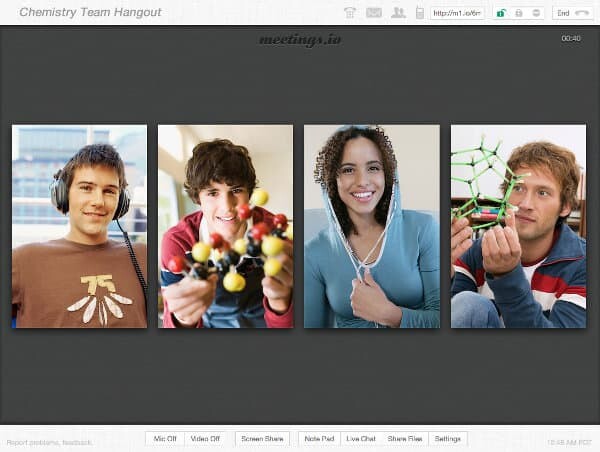Jive acquired Meetings.io, so it’s time to see how these two combine their offerings.
Meetings.io was one of these companies that worked on providing a Google Hangout like service. When they got acquired it seemed to make sense: Jive, a company developing social solutions for the enterprise, looking to add video communications to its arsenal of tools. I have written about this acquisition before, so when the opportunity to get an interview presented itself… I couldn’t help myself.

Denis Mars, Co-founder of Meetings.io, now a part of Jive, has been kind enough to answer my questions.
What is Meetings.io all about?
Meetings.io enables full voice/video/chat/file and screen-sharing in your browser without any software or plugins. We work out of the box with a wide variety of internet technologies. Additionally we don’t require a user to sign up or sign in. Setting up and sharing a meeting room is as simple as sharing and clicking a URL. We believe Meetings.io is the most simple to use meeting software on the market.
You decided to get acquired rather soon in the company’s cycle. Why is that?
We see the value in getting our technology to as many people as possible and work with a larger team that is investing in our technology to deliver fantastic real time experiences and p2p technologies. Jive presented us with this opportunity, large existing user base, and extensive resources that allow us to take real time communication and collaboration to the next level. Ultimately, working as part of Jive, we are reinventing how work gets done and delivering real business value to businesses.
What made you switch from Flash to WebRTC? How has that worked out for you?
We’re working on evolving our technology across all browsers and devices. We’re very excited with the promise of WebRTC and also acknowledge that we have to accommodate all users who may not be running the latest Chrome version and any other soon to be available WebRTC supported browser versions. Additionally, given Apple’s lack of participation and Microsoft’s Skype/Internet Explorer situation we’re currently building a robust system to handle the heterogeneous nature of the browser mark

Are you running Flash and WebRTC today in parallel or did you switch completely to WebRTC? If you are using them in parallel, then are you allowing for participants of both technologies to be in the same conference? How do you handle that?
We’re currently working on a hybrid model between the two systems. This will allow us to accommodate participants who are accessing the service from either WebRTC or Flash.
On the client side, what signaling solution have you used?
We have built a custom meeting signaling and orchestration system which handles inter peer communication and prevents split brain style state problems.
Can you tell me something about how your server side works?
We have both persistent RPC style business logic and real time servers to handle the differing workloads and backend tasks. We utilize relay servers when our UDP firewall traversal fail.
How was the integration with WebRTC?
We designed and built Meetings.io with WebRTC in mind. Although the first thing we needed to figure out was how we could reach the widest possible user base who’s browsers don’t support WebRTC. As such, we integrated Flash which gave us close to ubiquitous access to users media devices and also gave us P2P capabilities through the RTMFP protocol. We’ve been working with WebRTC for some time now.
Given the opportunity, what would you change in WebRTC?
We would like more access to flow control in the video capture “black box”. While Google’s implementation is great for JS web developers to get quick access to the camera feed, Flash currently gives us some nice levers for controlling just how much data the camera sends down the pipe by giving us access to adjusting the compression and quality settings of the captured video. Also, we’d love to have screen sharing available very soon and added to that the ability to securely control the other participants remotely.
What’s next for Meetings.io now that it is part of Jive?
We’re working on building amazing web based real time communication technologies and experiences into the Jive platform and ecosystem. Jive gives us a wonderful opportunity to reinvent how people work to deliver real business value in organizations. This will be delivered, in part, via online real-time communications systems that are aligned to their natural workflow. They will be less complex and formal and allow quick conversations and interactions with coworkers, customers, partners and clients effortlessly. We’ve got some big ideas and we’re excited to bring these to market.
–
The interviews are intended to give different viewpoints than my own – you can read more WebRTC interviews.
